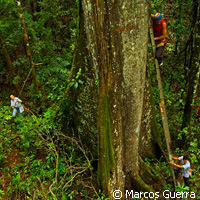Pollution disrupts tropical forests' nitrogen cycle
Anthropogenic activities play havoc with tropical forests by disturbing their nitrogen cycle, new international research shows. Presented in the journal Science, findings reveal the first evidence of long-term effects of nitrogen pollution in tropical trees. Scientists from Austria, Canada, Germany and Panama carried out their work at two remote Smithsonian Institution Global Earth Observatory sites in Panama and Thailand. 'Air pollution is fertilising tropical forests with one of the most important nutrients for growth,' says co-author S. Joseph Wright of the Smithsonian Tropical Research Institute in Panama. 'We compared nitrogen in leaves from dried specimens collected in 1968 with nitrogen in samples of new leaves collected in 2007. Leaf nitrogen concentration and the proportion of heavy to light nitrogen isotopes increased in the last 40 years, just as they did in another experiment when we applied fertiliser to the forest floor.' High temperatures and pressures found in stars help generate nitrogen; in its elemental form, it is colourless, tasteless and odourless, and does not readily react with substances. Over 75% nitrogen is found in the air and it acts as an essential protein component. A change comes about, making nitrogen 'active', when certain bacteria colonise plant roots, extract nitrogen from the air and convert or 'fix' it into a form required for growth. Once the bacteria no longer need the nitrogen, the plant takes up the gas, which can also be used by animals. We use the Haber process to fix nitrogen. This process converts nitrogen gas into ammonia, which is a ingredient commonly found in fertilisers. Experts say nitrogen fixation by humans has raised the amount of reactive nitrogen emitted by around 100%. According to the researchers, nitrogen comes in two forms or isotopes, atoms that have the same number of protons but different numbers of neutrons. With nitrogen, the isotopes are 14N and 15N, but just about 1 in 300 nitrogen atoms is the heavier form. Light nitrogen is lost through nitrate leaching and in the form of gases including N2, as well as certain forms of nitrous oxides or 'noxides,' some of which can be significant greenhouse gases. In the Panama-based fertilisation study, N2O emissions were three times higher. 'Tree rings provide a handy timeline for measuring changes in wood nitrogen content,' says Peter Hietz from the Institute of Botany at the University of Natural Resources and Life Sciences in Vienna, Austria. 'We find that over the last century, there's an increase in the heavier form of nitrogen over the lighter form, which tells us that there is more nitrogen going into this system and higher losses. We also got the same result in an earlier study of tree rings in Brazilian rainforests, so it looks like nitrogen fixed by humans now affects some of the most remote areas in the world.' Commenting on the findings of the study, co-author Ben Turner of the Smithsonian Tropical Research Institute in Panama says: 'The results have a number of important implications. The most obvious is for trees in the bean family (Fabaceae), a major group in tropical forests that fix their own nitrogen in association with soil bacteria. Increased nitrogen from outside could take away their competitive advantage and make them less common, changing the composition of tree communities. There are also implications for global change models, which are beginning to include nitrogen availability as a factor affecting the response of plants to increasing atmospheric carbon dioxide concentrations.' The researchers say years of atmospheric nitrogen deposition have resulted in many changes in plants and soils of temperate forests in Europe and the United States. The question now is whether tropical forests will suffer the same fate.For more information, please visit: Smithsonian Tropical Research Institute:http://www.stri.si.edu/Science:http://www.sciencemag.org/
Countries
Austria, Canada, Germany, Panama



